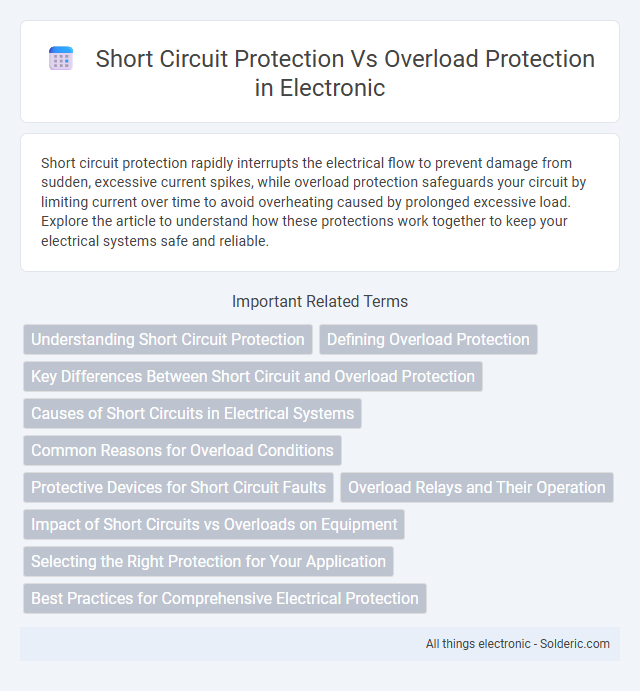Short circuit protection rapidly interrupts the electrical flow to prevent damage from sudden, excessive current spikes, while overload protection safeguards your circuit by limiting current over time to avoid overheating caused by prolonged excessive load. Explore the article to understand how these protections work together to keep your electrical systems safe and reliable.
Comparison Table
| Feature | Short Circuit Protection | Overload Protection |
|---|---|---|
| Purpose | Prevents damage from sudden, high current faults | Prevents damage from sustained excessive current |
| Trigger Condition | Instantaneous high current due to short circuit | Current exceeds rated load for extended time |
| Response Time | Immediate, fast acting | Slower, time-delayed action |
| Protection Device | Fuse, circuit breaker | Thermal relay, overload relay |
| Typical Application | Electrical wiring, motors, appliances | Electric motors, industrial equipment |
| Effect of Failure | Potential circuit damage, fire hazard | Motor overheating, insulation damage |
Understanding Short Circuit Protection
Short circuit protection safeguards electrical circuits by quickly interrupting excessive current flow caused by a direct contact between live conductors, preventing damage and hazards such as fires. It relies on devices like fuses and circuit breakers designed to detect high fault currents that result from a short circuit, ensuring immediate disconnection. Unlike overload protection, which responds to sustained overcurrent conditions, short circuit protection reacts instantly to sudden current spikes, maintaining system safety and equipment integrity.
Defining Overload Protection
Overload protection safeguards electrical circuits from damage caused by prolonged excessive current flow, which exceeds the rated capacity but is typically less severe than a short circuit. This protective mechanism uses devices such as fuses, circuit breakers, or thermal relays to interrupt power when the current rises above a safe threshold for an extended period. Understanding overload protection helps you prevent overheating and potential fire hazards in your electrical systems.
Key Differences Between Short Circuit and Overload Protection
Short circuit protection rapidly interrupts the electrical flow to prevent damage caused by a direct connection between two conductors, typically resulting in very high current. Overload protection, on the other hand, safeguards your equipment by detecting an excessive current caused by prolonged operation beyond the rated capacity, allowing the circuit to cool before disconnecting. Understanding these key differences helps ensure your electrical system is equipped to handle both sudden faults and sustained overcurrent conditions effectively.
Causes of Short Circuits in Electrical Systems
Short circuit protection addresses faults caused by unintended low-resistance connections between conductors, often triggered by damaged insulation, faulty wiring, or conductive debris, leading to sudden high current flow. Overload protection, on the other hand, manages excessive current draw over time due to equipment operating beyond its rated capacity, which heats and damages circuits gradually. Understanding causes like insulation failure, wire damage, or foreign conductive materials is essential for designing effective short circuit protection in electrical systems.
Common Reasons for Overload Conditions
Overload conditions commonly occur due to excessive current drawn by electrical devices beyond their rated capacity, often caused by faulty wiring, malfunctioning equipment, or prolonged use of high-power appliances. Short circuit protection instantly interrupts current flow when a direct connection forms between live and neutral wires, preventing damage from sudden high current surges. Understanding your circuit's load capacity helps prevent overloads and ensures the proper function of both short circuit and overload protection mechanisms.
Protective Devices for Short Circuit Faults
Protective devices for short circuit faults include circuit breakers and fuses designed to detect and interrupt high current surges instantly, preventing extensive damage and fire hazards. Short circuit protection focuses on quickly isolating the fault to safeguard wiring and equipment from extreme current flow. Your electrical system's reliability depends on these devices operating effectively to distinguish between normal overload conditions and dangerous short circuits.
Overload Relays and Their Operation
Overload relays protect electric motors from overheating by detecting excessive current flow caused by prolonged overcurrent conditions, preventing damage due to motor overload. They operate by monitoring the thermal or electronic response to current levels above the rated capacity, triggering a trip mechanism when the load exceeds safe limits for a set time. Your motor's safety and longevity depend on correctly selecting and setting overload relays, as these devices do not respond to short circuit faults, which require separate short circuit protective devices.
Impact of Short Circuits vs Overloads on Equipment
Short circuit protection is crucial for preventing immediate and severe damage to equipment caused by excessive current flow, which can lead to overheating, fires, or catastrophic failure. Overload protection, on the other hand, safeguards your equipment from prolonged exposure to currents above the rated capacity, which results in gradual wear, insulation breakdown, and reduced lifespan. Understanding the distinct impacts of short circuits versus overloads helps optimize safety measures and ensure the reliability of your electrical systems.
Selecting the Right Protection for Your Application
Selecting the right protection for your application requires understanding that short circuit protection instantly interrupts excessive current flow caused by faults, preventing damage and fire hazards, while overload protection safeguards circuits by responding to prolonged overcurrent conditions that cause overheating. Key factors include the nature of the load, response time required, and the sensitivity of connected equipment. Incorporating both devices, such as circuit breakers with integrated trip units, ensures comprehensive defense against diverse electrical faults.
Best Practices for Comprehensive Electrical Protection
Short circuit protection quickly interrupts current flow during a fault to prevent damage, while overload protection safeguards circuits from prolonged excessive current by tripping breakers or fuses. Best practices for comprehensive electrical protection combine both methods to ensure safety and equipment longevity, using devices like circuit breakers with dual functions or integrating ground fault interrupters. Your electrical system benefits from coordinated settings and regular maintenance to address both short circuit faults and overload conditions effectively.
Short circuit protection vs Overload protection Infographic

 solderic.com
solderic.com